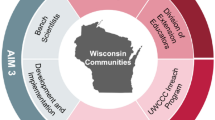Abstract
In the largely African American and Hispanic communities of East and Central Harlem in New York City (NYC), health inequities are glaring. Mortality from cancer is 20–30 % higher than in Manhattan and 30–40 % higher than rates in the general population in NYC. Despite advances in risk assessment, early detection, treatment, and survivorship, individuals in Harlem and similar urban communities are not benefiting equally. Guided by community-based participatory research, this study serves as an important step in understanding cancer care needs and the range of factors that impact the disparate rates of cancer in East and Central Harlem. Forty individual interviews were conducted with community leaders and residents. Major themes included: need for appropriate supportive services; health care access and financial challenges; beliefs related to stigma, trust, and accountability; and the impact of the physical environment on health. Education was seen as a critical area of need and intervention.
Similar content being viewed by others
References
Olson E, Van Wye G, Kerker B, Thorpe L, Frieden TR (2006) Take care East Harlem. NYC Community Health Profiles, 2nd ed 21(42):1–16
Olson E, Van Wye G, Kerker B, Thorpe L, Frieden TR (2006) Take care Central Harlem. NYC Community Health Profiles, 2nd ed 20(42):1–16
Myers C, Olson C, Kerker B, Thorpe L, Greene C, Farley T, New York Department of Health and Mental Hygiene (2010) Reducing health disparities in New York City: health disparities in life expectancy and death. Human Sciences Press, New York
Smith R, Cokkinides V, Brawley OW (2009) Cancer screening in the United States, 2009: a review of current American Cancer Society guidelines and issues in cancer screening. CA Cancer J Clin 59(1):27–41
Stokols D (1996) Translating social ecological theory into guidelines for community health promotion. Am J Heal Promot 10(4):282–298
Caplan R, Van Harrison R (1993) Person-environment fit theory: some history, recent developments, and future directions. J Soc Issues 49:253–275
Kaplan S (1983) A model of person–environment compatibility. Environ Behav 15(3):311–332
Bracht N, Gleason J (1990) Strategies and structures for citizen partnerships. In: Bracht N (ed) Health promotion at the community level. Sage, Newbury Park, pp 109–124
Thompson B, Kinne S (1990) Social change theory: applications to community health. In: Bracht N (ed) Health promotion at the community level. Sage, Newbury Park, pp 45–65
Green L, Anderson CL (1994) Community health, 7th edn. Mosby, St. Louis
Ashton J, Grey P, Barnard K (1986) Healthy cities: WHO's new public health initiative. Health Promot 1:319–324
Duhl L (1986) The healthy city: its functions and its future. Health Promot 1:55–60
Friedman AJ, Cosby R, Boyko S, Hatton-Bauer J, Turnbull G (2011) Effective teaching strategies and methods of delivery for patient education: a systematic review and practice guideline recommendations. J Cancer Educ 26:12–21
Waters JR, Darby J (2011) Health promoting community radio in rural Bali: an impact evaluation. Rural Remote Health 11(1):1555 (Online)
Jones P, Winslow BW, Lee JW, Burns M, Zhang XE (2011) Development of a caregiver empowerment model to promote positive outcomes. J Fam Nurs 17(1):11–28
Suter P, Suter NW, Johnston D (2011) Theory-based telehealth and patient empowerment. Popul Health Manag 14(2):87–92
Northridge M, Stover G, Rosenthal J, Sherard D (2003) Environmental equity and health: understanding complexity and moving forward. Am J Public Health 93(2):209–214
Schulz A, Northridge ME (2004) Social determinants of health: implications for environmental health promotion. Health Educ Behav 31(4):455–471
Freudenberg N, Galea S, Vlahov D (2005) Beyond urban penalty and urban sprawl: back to living conditions as the focus of urban health. J Commun Health 30(1):1–11
Northridge M, Nye A, Zhang Y, Jack G, Cohall AT (2011) “Third places” for healthy aging: online opportunities for health promotion and disease management in adults in Harlem. J Am Geriatr Soc 59(1):175–176
Acknowledgments
Grant support: Data analyzed in this study were provided by the Tisch Cancer Institute. Dr. Edwards' work was supported through a Research Supplement to Promote Diversity in Health-Related Research (R01CA120658). Conduits is supported by grant #UL1RR029887 funded by the National Center for Research Resources' Clinical and Translational Science Award (CTSA).
Author information
Authors and Affiliations
Corresponding author
Rights and permissions
About this article
Cite this article
Edwards, T.A., Jandorf, L., Freemantle, H. et al. Cancer Care in East and Central Harlem: Community Partnership Needs Assessment. J Canc Educ 28, 171–178 (2013). https://doi.org/10.1007/s13187-012-0430-4
Published:
Issue Date:
DOI: https://doi.org/10.1007/s13187-012-0430-4




